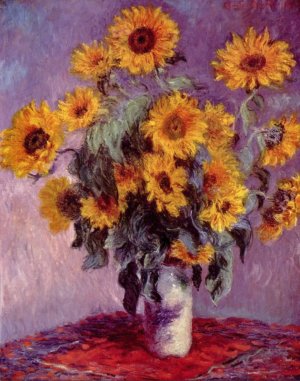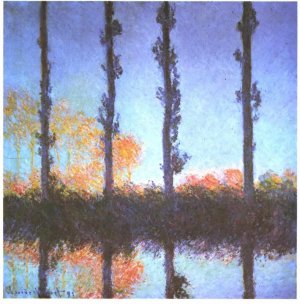He served two years in the military in Algeria on the continent of Africa, but he became ill with typhoid fever and was sent home to recover.
Monet had a small houseboat made. He would go out in the houseboat and paint scenes he saw from that view. He enjoyed painting outdoors observing how the light would change as the day progressed. He painted some scenes over and over again, and each would be different from the others because it was painted at a different time of day when the sun was at a different position in the sky. Monet was fascinated by light; the way it reflected off objects and the water in a pond. In his paintings he tried to capture this effect of light.
The Bouquet of Sunflowers was painted in 1881 and is a large painting, 39 by 32 inches. You can see it at The Metropolitan Museum of Art in New York.

Bouquet of Sunflowers
Enlarge
Enlarge
Monet made several paintings of Poplars. Each of them is quite different from the others in composition and color.

Poplars
Enlarge
Enlarge
He also created more than one painting of the Woman with the Parasol. In some of them the woman is the main subject of the painting and in others she is secondary to the landscape.

The Walk, Woman with the Parasol
Enlarge
Enlarge
Monet and several other artists experimented with a method of putting paint on the canvas without blending the colors. He would get the paint directly from the tube without mixing it on his palette first. Brush strokes and dabs of color would be placed side by side. Monet called it the "division of colours". When you stepped back from the canvas, your eyes would blend the colors together. This was not the traditional method of painting, and many people rejected their works.
In 1874 the artists decided to have their own art show at the studio of a photographer, G.F.T. Nadar who lived in Paris. More than 3,000 visitors came to the exhibit. The artists became known as "Impressionists" because Monet had titled one of his paintings " Impression - Sunrise ". Also some said the paintings looked unfinished and were just first "impressions". The artists who presented the show called themselves "Independents".
He married and he and Camille had two sons. Unfortunately Camille died a year after their second son Michael was born. In 1872 he made a painting of his wife reading a book. The painting is titled The Reader and is sometimes called Springtime. The light filtering through the trees looks like white flowers on her skirt.

The Reader (detail)
Enlarge
Enlarge
In 1883 Monet rented a house in Giverny, a village outside Paris. Several years later he bought the house and made his famous garden with the pond and Japanese bridge which are featured in more than 200 of his paintings. The latter part of his life was devoted to paintings made in his water garden.
Toward the end of his life his eyesight became poor, but he continued to paint until his death. In fact, when he died, he was working on a huge water lily painting that today hangs unfinished in the Orangerie of the Tuileries (tweel REE) Gardens in France.

This biography was written by Patsy Stevens, a retired teacher.
References:
Kostner, Thomas, and Lars Roper. 50 Artists You Should Know. New York: Prestel, 2006.
Order
Cunningham, Antonia. Impressionists, Bath: Parragon Publishing Book, 2000.
Order
Wilder, Jesse Bryant. Art History for Dummies. Hoboken, NJ: Wiley Publishing Inc, 2007.
Order


 A frequent question:
A frequent question: